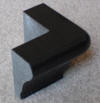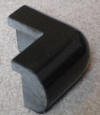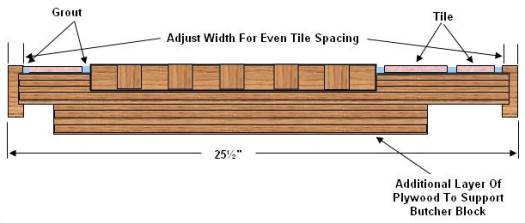Have you ever considered building kitchen or bathroom countertops from ceramic, porcelain or natural stone tiles such as marble or granite? Building countertops is something that most competent DIY home handymen can accomplish and is an excellent home improvement project. However, there is usually one area that causes problems. The front and side edges!
With the exception of a small quantity of ceramic tile, the edges on most tiles are not suitable as finished edges.
Some ceramic tiles have a bullnose
molded tiles as a trim, while others have one side slopped and finished. However, the limited availability of specialty or trim tiles, will force you into accepting tile countertops that may not suit your decor or personal aesthetic requirements
The easiest way around the problem is to use an oak frame to finish the edges. You will need a dado blade, preferably mounted on a table saw or a router and a sander to build perfect countertops.
Some of the specialty or trim tiles that are available in limited colors are shown below:

Bullnose

Martell

Corner Martell

Prescott

Corner Prescott
Even if you can find a tile that you like, that also has a wide variety of specialty tiles, it can still be complex to get the fit across a specific size of countertop. What it usually means is cutting tiles and edgings.
With a little thought you can produce a well designed, functional and aesthetically pleasing countertop, see Figure 1.

Figure 1 - Counter top with ceramic tile top, oak edging and built in butcher block cutting board.
The base for the ceramic tile should be an outdoor plywood, or a plywood that has had a couple of coats of sealer put on the face and edges. The oak trim allows you to adjust for the size of the individual tiles by changing the width of the top of the oak rail as well as adjusting the depth of the rabbit that fits over the edge of the plywood, see Figure 2.

Figure 2 - View of counter top construction cut away at butcher block.
If you are competent with the use of a router, I recommend that you use a router bit to form the edge of the counter tops. There are a variety of edges that can be developed using a router bit or combination of router bits, see Table 2.
Table 2 - Popular Edgings For Countertops |
|
 |
Bevel |
 |
Half Bullnose |
 |
Quarter Round |
 |
Straight |
 |
Bullnose |
 |
Ogee |
 |
Radius |
 |
Waterfall |
Rolled(available on formed laminate counter tops only) |
|
Most kitchen countertops, that contact a wall in the back, are 25 1/2 inches wide. Countertops for kitchen islands vary with the design of the island but should not be less than 25 1/2 inches wide.
Bathroom vanity countertops are generally 23 1/2 inches wide, although narrow units do exist, especially in powder rooms and small bathrooms where space is at a premium.
Although the drawings show the use of ceramic tile, the primary material used for the countertop material could be a hardwood such as oak or maple or you could even assemble the frame to provide for a stainless steel top.
